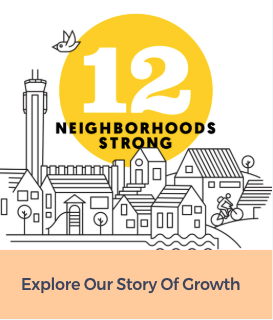IN THE BEGINNING.
It all started as a collaborative effort by business leaders, civic officials and citizens who wanted to have a say in how Denver should grow. The challenge was deciding what to do with this unique property: seven and a half square miles of prime real estate within the Denver city limits. The former Stapleton International Airport site could easily have been parceled out, resulting in a mishmash of subdivisions and industrial parks that had no contextual relationship to what was around them.
Instead, the organizers spent countless hours and much of their own money creating what became known as the “Green Book,” the guiding principles for the redevelopment of Stapleton International Airport. It has made all the difference and continues to be a vital touchstone for the community. Brookfield Properties (previously Forest City Enterprises), Central Park’s master developer, has brought the Green Book to life through a unique public/private partnership.
Today, Central Park still thrives at a grassroots level, thanks to the residents themselves. They are responsible for shaping the community into something better than anyone could have planned.
WHAT MAKES CENTRAL PARK’S PLAN SO INTERESTING.
Central Park connects to what’s around it. Respectfully maps onto Denver’s historic, urban, street pattern to the south and west, and with the high prairie open spaces to the north and east – continues what’s already there rather than ignoring it. Not just on a macro level but on a philosophical level, too.
Central Park’s inspiration comes from Aurora’s street patterns and Denver’s classic neighborhoods. In fact, the plan envisions Central Park as Denver’s next great community, with 12 great neighborhoods to date. It extends the metro area’s historic street patterns as well as Denver’s rich history of parks, tree-lined streets, parkways and welcoming front porches. It’s essentially the continuation of Denver’s rich urban fabric with trails and greenways linking Denver shops, restaurants, great schools, Colorado business districts, and of course, energy-efficient, new Denver homes.
Just as Central Parks’s first neighborhoods are defined by their connectivity to the historic street patterns, the new neighborhoods are defined by their connectivity to urban shopping and relationship to the land – woven more organically with parks and active green spaces. The new areas are also populated with garden-ready homes that honor Colorado’s high prairie agrarian heritage.
A REFRESHING ALTERNATIVE, NEW URBANISM.
It all adds up to one diverse, walkable experience. In Central Park, everything you need is just a short walk or bike ride away. Not a new idea, but a really good one. It’s a Denver community that’s human-scaled rather than car-scaled, much like what you find in your favorite small towns and urban boroughs throughout the world. Central Park has become a refreshing alternative to the suburban model … a place where all types of homes, from the $200s to $800s (base pricing) and all types of people exist happily, synergistically, together.
Here, you’ll find authentic architecture, public art, summer concerts and markets, and a certain pride of place where new homes stand tall and formally greet passersby.
The cumulative effect of all this careful planning is sustainability – a fancy word for lasting value – and the feeling you get when you like something but you don’t know exactly why. It just feels right. Better.
But maybe, when all is said and done, the most beautiful part of the Central Park’s plan is the part that opens the door for something wonderful and spontaneous to happen. Like when the residents and businesses that call it home put their stamp on it. And that is precisely what is happening at Central Park. Something greater than anyone could ever plan.



